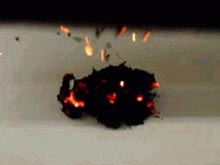
Succession of relationships keeps heavenly bodies young
Astronomers have uncovered a scandalous degree of promiscuity in the cosmos. Clusters where stars gather more densely than usual are veritable hotbeds of partner-swapping. Some stars engage in half a dozen or so relationships during their lifetime 1 .
Star clusters range from loose groups of ten thousand or so stars to dense globular clusters of a million or more. They exist throughout galaxies like ours

Animals may have beaten upright plants to land.
The oldest fossils of footprints ever found on land hint that animals may have beaten plants out of the primordial seas. Lobster-sized, centipede-like animals made the prints wading out of the ocean and scuttling over sand dunes about 530 million years ago. Previous fossils indicated that animals didn’t take this step until 40 million years later.
“It’s staggering that we thought for all this time that animals appeared on land

It sounds like a photographer’s worst nightmare: the light of the flashbulb causes the subject of the photo to burst into flames. But that’s exactly what happened recently when researchers snapped a picture of some single-walled carbon nanotubes, tiny cylinders of pure carbon. The findings, described in a report published in the current issue of the journal Science, suggest that the minute straws could be used as triggering devices or for remote light-induced ignition.
The discovery was ma

The scientists from I.P. Pavlov Institute of Physiology, Russian Academy of Sciences, have investigated the intellectual abilities of chimpanzees in comparison with the children from a nursery school in Koltushy near St. Petersburg. They asked both to build the pyramids of cubes of different size. The children with the retention of speech development aged from 2 to 7 and two chimpanzees, female (aged 7) and male (aged 11) ones, took part in the experiment. The children and the apes were shown a pyra

Researchers at the University of Warwick’s Warwick Process Technology Group have devised a process that turns wet waste from sewage farms and paper mills into a source of power.
University of Warwick researcher Dr Ashok Bhattacharya and his team are part of a Europe wide consortium that have cracked the problem of how to extract very pure levels of hydrogen from wet bio-matter, such as sewage or paper mill waste. This very pure hydrogen can then be used in “fuel cells” to power homes, factor

Is it possible to make components out of organic polymers (plastics) whose structure is such that severed nerves can grow right into them and connect with electrodes in a prosthetic hand, for example? This is one of the research fields for Tobias Nyberg at the Section for Biomolecular and Organic Electronics at Linköping University, Sweden.
Part of Tobias Nyberg’s dissertation is based on collaboration with cell biologist Helena Jerregård. Her task is to find ways to get tangled nerves to s

An international team that includes the University of Bath has discovered three ultra-massive galaxies (‘Red Monsters’) in the early Universe forming at unexpected speeds, challenging current models of galaxy formation….

An international team of researchers led by scientists from the Facility for Rare Isotope Beams uncovered evidence that astrophysics models of massive stars and supernovae are inconsistent with observational gamma-ray…

… could change how we use and control light. The new discovery could dramatically enhance technologies like lasers, sensors and optical computing in the near future. An international research team…

Rice researchers develop novel electrochemical reactor. A team of Rice University researchers led by Lisa Biswal and Haotian Wang has developed an innovative electrochemical reactor to extract lithium from natural…

… may soon be on your plate. The protein in sea lettuce, a type of seaweed, is a promising complement to both meat and other current alternative protein sources. Seaweed…

…gives crop breeders a wider lens. Understanding how both environmental conditions and genetic makeup affect crops is essential to developing varieties that are more resilient and productive. But the intricate…

New ISTA assistant professor Julian Léonard makes abstract quantum properties visible. From the realm of the abstract to the tangible, the new assistant professor at the Institute of Science and…

Engineers in Australia have found a way to make stronger and crack-resistant concrete with scrap carpet fibres, rolling out the red carpet for sustainability in the construction sector. The research…
With the increase of new technology and artificial intelligence, the demand for efficient and powerful semiconductors continues to grow. Researchers at the University of Minnesota have achieved a new material…

Carnegie Mellon University’s EgoTouch creates simple interfaces for virtual and augmented reality. The new generation of augmented and virtual reality controllers may not just fit in the palm of your…

Physicists create “light hurricanes” that could transport huge amounts of data. Much of modern life depends on the coding of information onto means of delivering it. A common method is…

A new approach to beam shaping will soon make additive manufacturing more flexible and efficient: Fraunhofer ILT has developed a new platform that can be used to individually optimize laser…